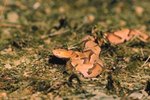
If you ever catch a glimpse of a turtle with a striking red stripe on the side of his head, then he's probably a red-eared slider (Trachemys scripta elegans). These mid-sized freshwater creatures are hard to miss because of these vivid elements of their appearance. Many people keep these semiaquatic turtles as pets.
Red-Eared Slider Turtle Basics
Mature red-eared slider turtles usually have upper shells between 5 and 11 inches in length. They generally weigh no more than 2 pounds or so, although the girls are usually bigger than the boys. These turtles typically inhabit sluggish and calm waters that feature plentiful vegetation, whether creeks, sloughs, swamps, lakes or ponds. They also gravitate to settings that are home to lots of places to bask -- think logs and stones. Red-eared turtles also like water environments with mud on the floor. Food-wise, they consume lots of beetles, tadpoles, snails, water plants and fish, which they seek out at the start of the morning and then again as the afternoon draws to a close. Reproductive activities are possible at any point in the year bar the summer months.
Basic Coloration
Red-eared sliders have brown or deep green upper shells, with mostly yellow plastrons. Their plastrons also display some dark spots. The skin that covers their legs, necks and most of their heads is green and adorned with narrow bright yellow streaking.
Red Stripes
Since the overall green or brown colors of red-eared sliders is rather subtle and muted, the wide red stripes situated on their heads -- behind both of their eyes -- are extremely easy to notice. The crimson stripes are the reason for the common name for these turtles, after all.
Not Always Red
The name "red-eared slider" might make you think that the stripes are red 100 percent of the time, but that simply isn't the case. Although uncommon, some red-eared slider turtles have orange or yellow markings on the sides of their heads instead of red.
Pigmentation
The red stripes of elderly male red-eared sliders are sometimes hard or impossible to detect. Aged males sometimes have inordinate amounts of dark pigmentation that can totally block out their red markings. This also often occurs with their yellow striping, as well. This is known as melanism, and it sometimes results, with time, in full black coloration.
References
- ReptileChannel.com: Red-Eared Slider Turtle Information and Care
- Texas Parks & Wildlife: Red-eared Slider
- United States Geological Survey: Red-eared Slider
- Ohio Department of Natural Resources: Red-eared Slider
- Michigan Department of Natural Resources: Red-eared Slider
- Maryland Department of Natural Resources: Red-eared Slider
- Missouri Department of Conservation: Red-eared Slider
- Virginia Department of Game & Inland Fisheries: Red-eared Slider
- City of Manhattan, Kansas: Red-eared Slider
Photo Credits
-
Hemera Technologies/PhotoObjects.net/Getty Images




